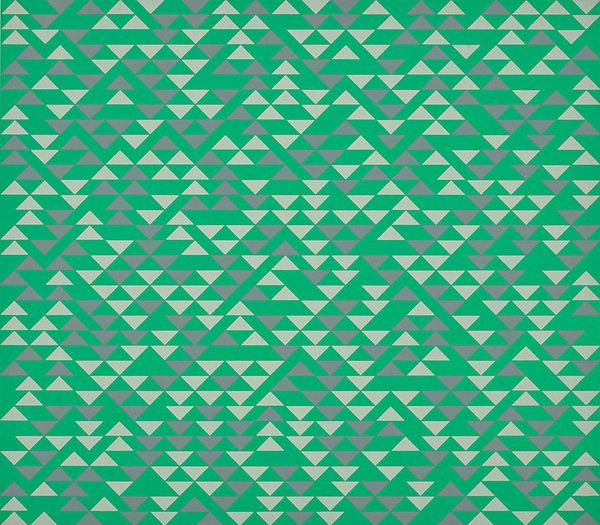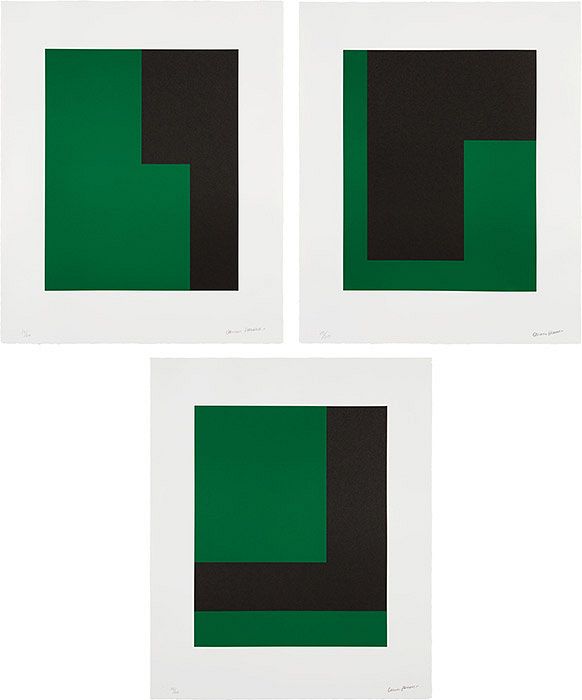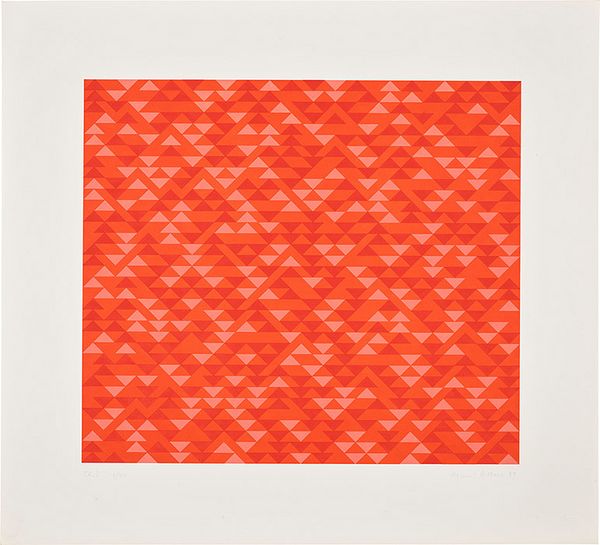Anni Albers, TR II, 1970, lithograph. Editions & Works on Paper.
Featured in our Editions & Works on Paper auction on 27 June in New York are seven women artists who reinvented abstract art as we know it, from the 1940s to the current moment.
In this piece, we cover Geometric Abstraction:
Anni Albers
Agnes Martin
Jo Baer
Carmen Herrera
In another, we look at acclaimed masters of Gestural Abstraction (read now):
Lee Krasner
Joan Mitchell
Pat Steir
Some in our selection were unjustly eclipsed from the history of art until only recently because they were women. Others were the rare exceptions who were able to achieve critical attention and acclaim on par with their male contemporaries. All are now recognized for their contributions in advancing abstract art through some of most important movements in the 20th century. And, happily, all made prints.
Agnes Martin
Agnes Martin, Agnes Martin Paintings and Drawings 1974–1990, 1991, complete set of ten lithographs. Editions & Works on Paper.
Known for her reductive style of soft, hand-rendered grids and lines, the abstract painter Agnes Martin (1912–2004) has long been widely revered as among greatest artists of the 20th century. A strong and independent woman, she saw her first success in New York, but is famous for escaping to the relative isolation of New Mexico in 1967, which was to better serve her approach to artmaking as a meditative practice.
Martin’s decade in New York began in 1957 with an invitation from her gallerist Betty Parsons. It was a productive period for her, despite her struggles with schizophrenia, that culminated in her participation in the exhibition Systematic Painting at the Guggenheim in New York in 1967, alongside minimalist artists Donald Judd and Sol Lewitt. While some identify Martin as a minimalist, she firmly rejected that movement’s intellectual program. She was inspired by Rothko. Ad Reinhart was her friend and mentor. She chose to take her art in a deeply personal, spiritual direction into the realms of serenity, tranquility, and joy that she felt connected her more to the abstract expressionists.
The ten lithographs on offer comprise the complete set of the portfolio Agnes Martin Paintings and Drawings 1974–1990, which were published to celebrate the artist's 1991 retrospective at the Stedelijk Museum, Amsterdam.
Jo Bear
Jo Baer, #2; #3; #5; #8; and #9, from Cardinations, 1974, silkscreens. Editions & Works on Paper.
Jo Baer (1929–) was a key player in the minimalist movement of the 1960s in New York, celebrated for pushing abstraction in painting to its absolute limits. Her radically pared-down, hard-edge, non-objective works appeared in many of the first minimalist art exhibitions alongside the work of such seminal artists as Donald Judd, Dan Flavin, Robert Morris, and Sol Lewitt.
Baer’s daring moves — which included leaving canvases almost entirely blank — stripped painting down to its essence. Her cerebral, ascetic approach to creating abstract art commanded the respect of her colleagues in the movement — particularly Dan Graham and Dan Flavin — beyond what other women could achieve in that era. As a writer, she helped to articulate the movement’s conceptual program, as she fiercely defended the relevance of minimalist painting. In 1966 came her first one-person exhibition at the Fischbach Gallery — then an important venue for avant-garde art in New York. She had broken through as a formidable, fiercely independent force on her own. The next year, she appeared in Documenta IV. And in 1975, The Whitney Museum of American Art honored her with a mid-career retrospective.
In our auction are five plates from Joe Baer’s famous Cardinations series of 1974, during the peak of her career. Each plate features a cardinal number inscribed on a circle that Baer has created to represent a concept. Included in this group are the following subjects: 2 = Drawings; 3 = Prints; 5 = Media; 8 = Bibliography; and 9 = Contact.
Carmen Herrera
Carmen Herrera, Verde y Negro, 2016, complete set of three lithographs. Editions & Works on Paper.
Significant recognition came to Carmen Herrera (1915–2022) in the mid-2000s, after fifty years of pioneering explorations of color and form in painting and sculpture. Marginalized as a woman and a Cuban immigrant, she had difficulties breaking through. Today, she is celebrated as a central figure in the pantheon of geometric abstraction.
Trained as an architect in her native Havanna, Herrera immigrated to New York in 1939. Already invested in her life-long “quest…for the simplest of pictorial resolutions,” she pursued studies in painting at the Art Students League and printmaking at the Brooklyn Museum. Her vision came into focus in Paris where she lived from 1948 to 1953, finding inspiration in the Bauhaus aesthetic and Russian Suprematism to develop a hard edge, non-objective style of expertly balanced geometric shapes and pure colors. In retrospect, her early works invite comparison to Ellsworth Kelly and we can see that she anticipates the achievements of Lygia Clark and Hélio Oiticica and others of the Brazilian Neo-Concrete Movement by as much as a decade.
Herrera created the portfolio Verde y Negro in 2017, at the age of 102. The artist published fewer than 20 editions in her career — her first only in the 1990s, as the market for her work began to develop. As a testament to Herrera’s popularity in 2019 and the success of this edition, Uniqlo selected it as the centerpiece of a collection they created in partnership with MoMA to celebrate the museum’s expansion.
Anni Albers
Anni Albers, TR I, 1970, lithograph. Editions & Works on Paper.
The work of Anni Albers (1899–1994) is characterized by dynamic geometric imagery, with shapes overlapping and arranged to create complex and engaging compositions. She carried out her pioneering explorations mainly in textiles until 1963, when she added printmaking to her repertoire. She is revered today — alongside her husband, Josef Albers — as one of the most important artists of the 20th century.
Anni Albers had discovered her vision and found her style at the Bauhaus in Germany, where she trained and taught early in her career. Initially, she’d been nudged away from painting into textiles because of her sex. Nonetheless, as a visual artist working in textiles, Albers pushed forward the language of abstraction she’d discovered in the paintings of Kandinsky and Klee, her colleagues at the Bauhaus. Her achievement was recognized as early as 1949, when she became the first textile artist to have a solo show at the Museum of Modern Art in New York. A new chapter dawned for her in the 1950s, when she was to find new inspiration in the vibrant colors, repetitive geometric patterns, and immaculate sense of spatial balance in traditional Andean weaving.
In the artist’s Triadic series of 1970, Albers deftly blends Bauhaus and Andean influences to invite our eyes to dance through dynamic orchestrations of interlocked triangles. In 1970, the year she created them, Albers withdrew from her textile practice to devote herself full-time to printmaking. Her hands-on technical facility as a weaver made for a natural transition; and the sharper lines of lithography and screenprinting enabled her to render her forms and patterns with a more startling clarity.
Recommended Reading:




